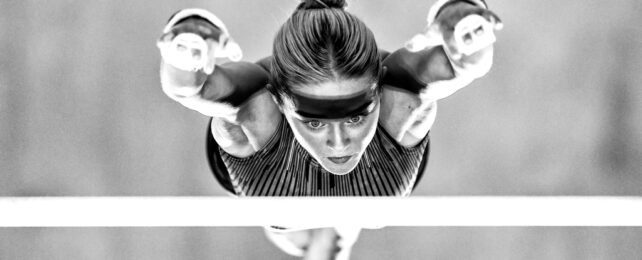ARTICLE AD
 Gymnast Ruby Evans of Team Great Britain during a training session on 21 July 2024 in Reims, France. (Naomi Baker/Getty Images)
Gymnast Ruby Evans of Team Great Britain during a training session on 21 July 2024 in Reims, France. (Naomi Baker/Getty Images)
Olympic gold is awarded to bodies of all shapes and sizes, all perfectly tuned to meet the high standards demanded of their field. Virtually every system is primed to push the physical limits of speed, precision, strength, and endurance.
The question of what makes an elite performer's brain different to ours has received no small amount of attention over the years.
Just as peak fitness and extraordinary strength are common to most athletes, numerous features of the nervous system set Olympians apart from the rest of us mere mortals.
From the very moment the body senses a change in their surroundings, highly trained athletes have an edge.
Bombarded with random sound stimuli – such as the noise of the arena, the distant rumble of a passing jet, the crackle of an announcer's speaker – the athlete's brain needs to quickly determine which sounds are critical to their success and which are distractions.
A 2019 cross-sectional study led by scientists at Northwestern University in the US found student-athletes across various top-division sporting teams have a larger response to sound than age and sex-matched controls.
An analysis based on brain-wave readings suggested the athletes were better at tuning out extraneous noise, focusing in on target sounds with far less distraction.
While much of this could be put down to the practice of honing in on the coach's bellows from the sidelines, some of the athletes studied played in traditionally less cacophonous surroundings, like a golf course. Something about regular training and focus could itself be responsible for shaping the brain's ability to screen out distraction.
It's not just sound, either. An investigation published in 2018 found skilled tennis players can stretch out the moments of intense visual focus, what is commonly referred to as a period of 'quiet-eye'.
Led by researchers at Florida State University, the study found that not only did the more skilled players have longer quiet-eye periods, but those expansive periods of focus were associated with better shots. A literature review by the same researchers on other sports found this association of skill and quiet-eye period wasn't exclusive to tennis.
Armed with detailed information about the state of play, a top-performing athlete needs to transform it into winning action.
Motor actions are largely coordinated by the brain's outer layer, or cortex – which in elite divers has been shown to increase in thickness in areas such as those associated with spatial awareness and perception of the body's motion.
Pathways between cortical regions and a cluster of neurons in the forebrain known as the striatum, which is critical for lining up sequences of movements, also seem to be enhanced in high-level athletes.
Scientists from the Max Planck Institute for Human Cognitive and Brain Sciences in Germany demonstrated that three athletes highly-skilled in javelin throwing and long jumping also had significantly different cortico-striatal circuits than matched controls.
While it's far from a large sample, their 2015 study goes some way to showing how the highways connecting regions of the brain involved in coordinating different movements to achieve a goal are different in highly trained athletes.
There's no doubt some people are born with brains that have an easier time expanding the circuits necessary for tuned listening, quiet-eye, and razor-sharp reactions, just as some are born to develop stronger muscles.
Yet many Olympic-level athletes might be born with an ace up their sleeve – a chemical kick that pushes them a little harder to seek glory.
Geneticists from the University of Parma in Italy published a study in 2015 that assessed four genes involved in muscle development and behavior, particularly aggression and anxiety.
Of particular note was the dopamine active transporter (DAT) gene, known to be involved with energy expenditure, movement, and reward-seeking.
Other studies suggest sensation seeking is common among athletes, especially those involving risk-taking, like skiers and snowboarders.
It seems likely that many of those who push themselves to win Olympic gold are driven to shape their brains into performance engines capable of pushing the rest of their bodies to the limit.

 3 months ago
28
3 months ago
28 

